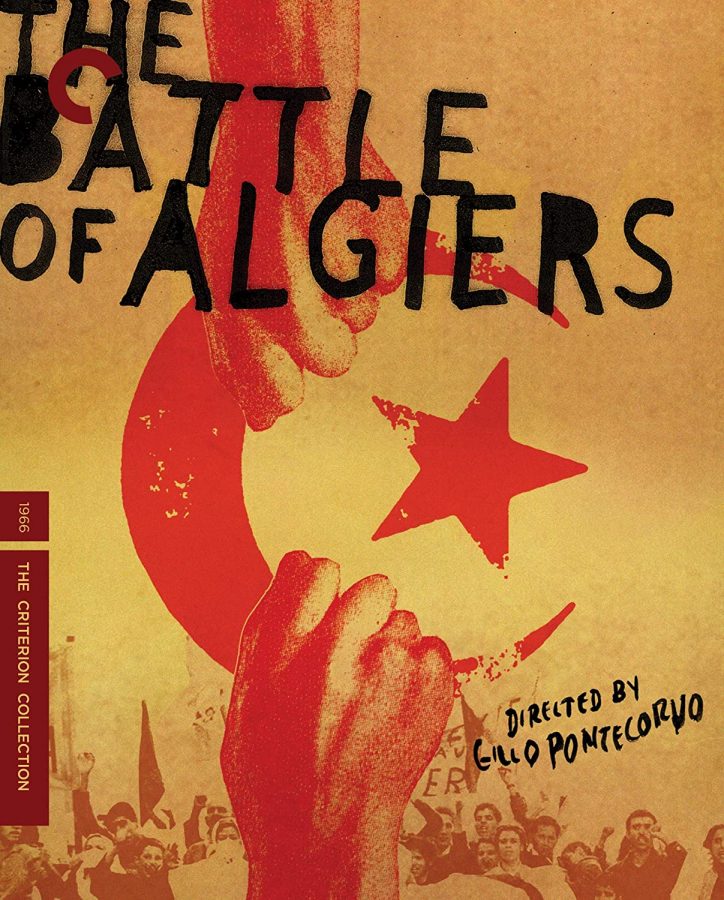Classics Review: “The Battle of Algiers” is as hard-hitting today as it was before
February 14, 2021
Italian director Gillo Pontecorvo’s 1966 historical war film “The Battle of Algiers” stands as an explosive masterpiece of modern cinema. It is influential not just as a political film, but also as an innovative work of documentary fiction.
The film is based on the country of Algeria’s struggle for independence from France in the 1950s. It mainly focuses on revolutionary leader Ali La Pointe, played by Brahim Haggiag, as he helps mobilize the guerrilla fighters of the National Liberation Front (FLN) inside the Casbah citadel in the city of Algiers. They target the pieds-noirs, a minority group of Europeans who were born in Algeria, by committing acts of violence. Algerian women plant bombs in crowded areas, while children shoot unsuspecting policemen in the streets.
The violence escalates to the point that France deploys French Army paratroopers to Algiers. Led by Colonel Mathieu, played by Jean Martin, the paratroopers fight dirty as well. They resort to illegal methods, such as summary executions and torture in order to root out and eliminate members of the FLN one by one. The film unsparingly depicts the atrocities that both the FLN and the paratroopers commit, all in the name of restoring peace and order in Algiers.
What first strikes the viewer is that “The Battle of Algiers” looks and feels like a documentary. In fact, one can be forgiven for mistaking it as such. The film was shot in black and white by Pontecorvo and cinematographer Marcello Gatti in a newsreel style inspired by Italian neorealist cinema. It was so convincing that when the film was later released in the United States, it was marketed with a notice that “not one foot” of newsreel footage was used.
The participants also add to the unnervingly real proceedings of the film. It was based on former FLN commander Saadi Yacef’s accounts of the Algiers campaign; he also stars in the film as Ali’s commander Djafar. Pontecorvo also chose to cast Algerians with the exception of Martin, who was a professional actor. It has always been a hallmark of Italian neorealist cinema to cast non-actors, and in the case of “Algiers,” it was portrayed to chillingly real effect. The fact that they would go along with the film’s explosive sequences, which would not be possible today, is astonishing.
Sound is also an important attribute in the film. The FLN and the paratroopers are distinguished by their motifs, with the former signaling their presence by military-style music compared to the latter’s primitive yet hard-hitting sounds of chanting and wailing. Ennio Morricone contributes to the film’s score, in what should be parallel to his memorable work for Sergio Leone’s spaghetti Westerns.
The legacy of “The Battle of Algiers” mostly lies in its timeless commentary on urban guerrilla warfare. It depicts insurgency tactics in an unsparing way and shows both sides as being complicit in the cycle of violence that breaks out in Algiers. Moreover, the film was studied by radical organizations as varied as the Black Panthers, the Irish Republican Army, and the Palestinian Liberation Organization. In fact, the Pentagon screened the film in 2003 in an effort to shed insight into how the occupation of Iraq might be handled.
The film distinguishes itself as a must-see for aspiring filmmakers and cinephiles alike. Stanley Kubrick once remarked that one “couldn’t really understand what cinema was capable of” without seeing the film. “Algiers” has influenced the introduction of political thought into cinema, from Costa-Gavras’s conspiracy thriller “Z” to the work of Oliver Stone. Pontecorvo has created a universal masterpiece with “The Battle of Algiers,” one that earns its place among the greatest films of all time.
To watch “The Battle of Algiers” on The Criterion Channel, click here.









